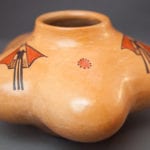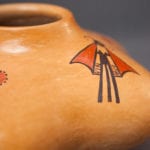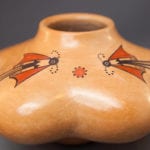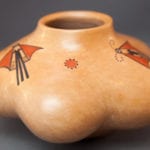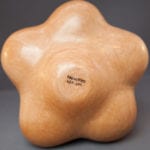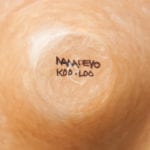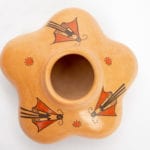This is a simple, elegant and peaceful jar.
The five lobes on the jar are formed by pushing out the walls of the wet clay vessel. The smooth exterior feels sensuous in the hands. The widest diameter of the jar is 5 times the size of the small 1.3125” base, thus the vessel seems to float upward. The jar mouth is not quite twice as wide as its base. The surface is very evenly blushed from the traditional dung firing. Remember, this is a coil-built vessel, so its perfect symmetry enabling it to balance on its tiny base is a technical as well as as aesthetic triumph.
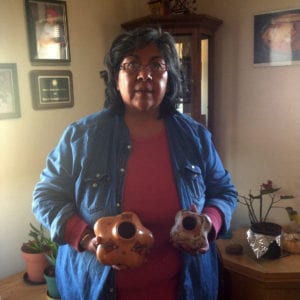
Rachael with her lobed pot in her right hand and Nampeyo’s lobed pot 2015-12 in her left hand
As noted in my discussion of jar 2015-12 (a lobed jar by Nampeyo), except for this singular Nampeyo example and these lobed jars by Rachael, such forms are unknown at Hopi. Rachael tells me she was inspired to begin making such forms by a lobed Nampeyo jar in the collection of the Museum of Northern Arizona. Ed Wade has also refered me to the lobed Nampeyo MNA jar, but a review of all of the museum’s “Nampeyo” pots plus a review of all of the “odd, eccentrically-shaped Hopi pots” in the MNA collection reveals no such lobed jar, much less one by Nampeyo. The source of Rachael’s inspiration remains a mystery to me. There is a lobed object in the Thomas Keam Collection of Polacca pottery at the Peabody Museum, Harvard, but from the photograph I cannot tell if it even has a bottom (Wade and McChesney, 1981:451). I know Rachael has visited this collection and so perhaps both she and Ed misremember the lobed pot as being at the MNA.
When I visited Rachael in her Mom’s home on May 11, 2016 and purchased jar 2016-05, I was able to hand her the lobed Nampeyo jar (2015-12). Rachael’s delight and exclamations and the careful way her fingers explored “Grandmother’s” pot are a memory I treasure.
The design on jar 2016-05 has two elements, a butterfly and a large red dot encircled by small black dots. Each element is repeated three times alternately.
The butterflies are built around a black, three-tailed form that merges into a wider core topped by double arrowheads. Flanking this core are two red wings with curved rear edges. About 75% of the space between the central black core and the red wings is left unpainted, but small speckled areas indicate the rear limits of the body. A simple black circle surrounding a curlicue represents the head; two curved dotted lines form the antennae.
The second design element is simply a large solid red dot encircled by from 9 to 11 small black dots.
I imagine that these circular elements represent flowers toward which the butterflies are fluttering to feed.
Together the two design elements represent a core Hopi/Tewa belief: “Siitalpuva”:
“…a colorful, glittering, flowery paradise.…’along (or throughout) the flowery land,’ ‘along the fields in bloom,’ ‘the land brightened with flowers’ …..This flowery world is not a separate place, like the Christian Heaven, but a reality that can be brought forth in this world… (Hays-Gilpin and Schaafsma, 2010: 122. Also see Hays-Gilpin and Sekaquaptewa, 2006:14).”
Reinforcing this sense of Siitalpuva is that when viewed from above, the mouth of the jar appears to be the center of a flower, surrounded by five petals, with butterflies hovering above it all. While a viewer’s eye acknowledges both the form and decoration of this vessel, the minimal decoration allows the graceful gourd shape to dominate perception. The result is a sweet, Zen-like serenity.



